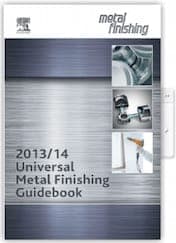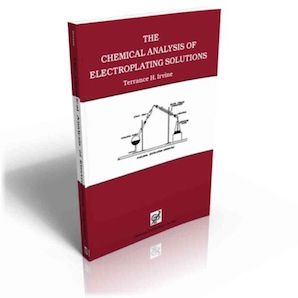
Curated with aloha by
Ted Mooney, P.E. RET

The authoritative public forum
for Metal Finishing 1989-2025

-----
Analyze acid copper plating solution
Q. We have a 20 gal tank with a copper/acid mixture. We would like to test for copper content and for acid content.
Is there a simple testing method available for checking these two components, either a test kit or a methodology procedure?
Wayne & Sybil DeBrusk1997
sometimes on
AbeBooks or Amazon
(affil links)

free pdf is currently available from academia.edu
A. You have not provided enough information. What acid? Copper plating or copper stripping. For control or for EPA?
For about $36 you can get a subscription to Metal Finishing which includes procedures for wet chemistry testing in its Guide Book. Also has lots of vendor information. It is one of the few good deals left. Hach and a few others make some drop test equipment and solutions. With the micro titrator, Hach's is very accurate. Drop testing is an approximation or an educated guess.
James Watts- Navarre, Florida
1997
----
Ed. note Nov. 6, 2017: The Metal Finishing Guidebook is now history, but you hopefully get a used copy or view it online.
by Terrance H Irvine

on eBay or
AbeBooks
or Amazon
(affil links)
A. If the acid is sulfuric acid or hydrochloric, titrate for the acid, 10 cc sample, dilute to 100 cc with water, Normal caustic soda ⇦liquid caustic soda in bulk on Amazon [affil link] to a methyl orange ⇦ this on eBay or Amazon [affil links] (yellow endpoint) or bromophenol blue ⇦ this on eBay or Amazon [affil links] (blue end).
1 ml N NaOH = 0.049 g H2SO4.
1 ml N NaOH = 0.0365 g HCl
Heavy metal content (if only Copper is present, Bingo)
10 ml sample, add 10 ml of 100 vol H2O2 and raise to the boil, heating until all oxygen is driven off, dilute to 200 ml, heat to 70 °C. Precipitate the iron using ammonia ⇦ this on eBay or Amazon [affil links] as in method 42, Then proceed as in method 43.
From Langford and Parker, Analysis of Electroplating and Related Solutions [on Amazon, ... on AbeBooks affil links].
Is this what you were looking for?
If so, I can get you the rest.

Tom Pullizzi
Falls Township, Pennsylvania
1997
A. If you want to skip with the chemistry and just use a simple premixed test kit, contact Kocour Co. in Chicago Illinois.
regards,
Dave
SUNNYvale California

Dave Kinghorn
Chemical Engineer
SUNNYvale, California
1997
Bluestone concentration by hydrometer
Q. I have three 375 gallon acid copper plating tanks. My main employee would always check and cut the tanks as needed. After 33 years he is gone. The blue stone will not elute or dissolve with heat. We are lost in how to cut these tanks. The blue stone has almost stopped the air pumps because of the build up. Can any one help with info or where to go for charts or books how to?
Phil Johnson- Indpls, Indiana
2001
A. Phil, the concentration of "bluestone" or copper sulphate ⇦ this on eBay or Amazon [affil links] in your bath can be measured by using a Hydrometer to measure the Density. There are Tables available in most Electroplating Text books. Or you could measure the Density of the bath when it has just started to crystallize and settle on a Density slightly lower as your maximum limit. After dilution(cutting) the Density is taken and then you have a "range".
Good luck.
Patrick Wm. McILVENA- Melbourne, Victoria, Australia
2001
A. Further to Pat's suggestions, the SG tables are a combination of both the copper sulphate and sulfuric acid. When you dilute you will also be lowering the sulfuric acid which will need to be increased to the suggested level. Thus you will need to lower the SG to a level well below the saturation level particularly as you have tanks that are increasing in copper content. It is really necessary to do an analysis to know where your copper and sulfuric are either before or after dilution or you are really in the dark. What will happen with plating is that the copper will increase and the sulfuric acid decrease, so regular additions of sulfuric acid should be made and no copper sulphate.

Geoffrey Whitelaw
- Port Melbourne, Australia
2001
Analyze fluoboric acid copper bath
2001Dear Helper
Our company is manufacturing Lead Wire for condensers.
Our process is fluoborate copper plating after sodium cyanide copper strike for steel.
I'm very pleased to ask you some questions.
I want to know test method or analysis method for organic contamination and fluoboric acid, boric acid in bath and analysis method SCN- without Hull Cell.
First, in fluoboric copper plating bath,
I want to analysis concentration fluoboric acid.
I was used method fluoboric acid a 5.0 ml sample of the solution into a 125 ml Erlenmeyer flask
⇦[125 mL flasks on
eBay or
Amazon [affil links]
and add 50 ml distilled water and 3-5 drops of methyl yellow (reagent I-4). Titrate the solution while swirling with 1.0 N NaOH (reagent S-3a) until the last trace of pink disappears and before the solution turns green.
g/Liter fluoboric acid HBF4 = ml NaOH x N NaOH x 6.17 g/Liter x 0.133
= oz/gal
The problem I have is that the end point isn't as clear as I would like it to be. So I tried BCP ( bromocresol purple ⇦ this on eBay or Amazon [affil links] ) and methyl orange ⇦ this on eBay or Amazon [affil links] but same result.
Second, I want to express degree of efficiency after carbon treatment.
The third, in sodium cyanide copper strike bath. I want to analysis sulphate an instance -SCN.
Thanks much,
TH Kim- An-san city, Korea
Endpoint for copper analysis
2003Q. Hi there!
I am having problems with the copper content analysis procedure we are using. The laboratory manual we're using states that the end point of titration is just right a drop after the solution turned into deep violet. We're following this for quite sometime now but we still have reports of soft copper plated from the said baths.
What is the appropriate end point color for the titration? Our titration procedure goes:
1) Pour 1 mL copper electrolyte solution in an Erlenmeyer flask.
2) Add 50 mL demineralized water.
3) Add 3 drops ammonia.
4) Add 0.50g murexide
[affil links].
5) Titrate with EDTA.
Our current end point color is of the same hue as that of a 1M permanganate solution. We are testing for copper content of an acid copper-copper sulphate solution. Please help.
Thanks,
Hazel DacilloRotogravure production - Malabon City, Metro Manila, Philippines
A. I hope that you mean half a gram of murexide [affil links]-salt indicator. I find that you need to play with endpoints for the different indicators. You might try a normal titration. Then try one with 0.1 grams of indicator to a faint end point. Add another 0.1g to the same solution. If you over shoot, add 1 drop of the copper solution and continue the titration. You can go back and forth several times on the same sample. Keep titrating until you have made enough runs to be at a 1.0 gram of murexide indicator. Will have to look at my books tonight. I thought that a "Starch-iodine" endpoint was the normal analysis for copper.
James Watts- Navarre, Florida
2003
|
A. I'm not too confident on using the murexide titration for Cu concentration in an acid Cu bath; I'd try a sodium thiosulphate ⇦ this on eBay or Amazon [affil links] titration instead.  James Totter, CEF - Tallahassee, Florida 2003 A. You need more ammonia solution when until blue color. (nickel+ammonium complex ion) looking for good result. SE DO JANG- Korea 2003 |
A. While I agree with the advice re the analysis technique perhaps Hazel should be looking at other causes for her soft copper problem rather than copper metal concentration.

Geoffrey Whitelaw
- Port Melbourne, Australia
2003
A. I agree with Geoff, you need to check the additive concentration and feed system if applicable. The copper content of the bath will have minimal impact on deposit hardness.
Russell Richter- Danbury, Connecticut, USA
2003
A. In most cases murexide is used in only titrations pertaining to electroless solutions. I use sodium thiosulphate as the titrant. The procedure is as follows, 5ml Cu solution, 100ml D.I. H20, 2ml NH4OH, heat to a boil for 15 min,remove from heat add 10 ml acetic acid ⇦ this on eBay or Amazon [affil links] ,cool solution add 25 ml potassium iodide,titrate with sodium thiosulphate to a pail yellow,add 1.00g starch indicator solution will turn grey,continue titrating with thiosulphate until white end point(ml thiosulphate)1.336 will give you grams per liter of Cu.Hope this is what you were looking for.
Andy White- Columbus, Ohio, USA
May 10, 2011
Chloride analysis in acid copper plating bath
Q. We currently use a Brinkman Auto-Titrator to check the Chloride ppm's in our Acid Cu Baths. The titrator has failed and we need another form of analysis without mercury (Hg). Any suggestions? HELP!
Larry Boehm- Owego, New York, USA
2005
A. Fix the titrator.
James Watts- Navarre, Florida
2005
A. I, too, would get the titrator fixed ('cause you can use it for a lot of other things), but an ion specific electrode method would work.

James Totter, CEF
- Tallahassee, Florida
2005
A. Hi neighbor, well one option is to use a outside lab that is close to you..
Linda Croft- Endicott, New York
2005
A. This procedure for the gravimetric determination of Cl- in CuSO4 baths is lifted from "Analysis of Electroplating and Related Solutions" [on
AbeBooks or
eBay or
Amazon affil links]
by Langford/Parker:
Pipette
[pipettes on
eBay or
Amazon [affil links]
100 ml of solution into a 500 ml beaker [beakers on
eBay
or
Amazon [affil links] . Add 5 ml conc. HNO3 and 10 ml 0.1N KMnO4 solution. Stir, then add 15 ml 0.1 N AgNO3 solution. Boil until the AgCl is completely coagulated, filter through a tared sintered glass crucible, wash well with 2% HNO3, then dry at 110 °C and reweigh.
Wt AgCl (in grams) X 2.474 = g/l Cl- in bath.
(My note: a Gooch crucible fitted with a fiberglass filter mat would likely work too).
Hope this is of some help.

Dave Wichern
Consultant - The Bronx, New York
2005
A. Do an internet search for the Fajan's method. It has numerous advantages over the gravimetric method or an ISE method.

Jon Barrows, MSF, EHSSC
Independence, Missouri
2005
Q. I want to know how can we analyse that we have chloride in hard copper plating bath.
gaura shah- Hyderabad,A.P., India
October 30, 2014
October 2014
Hi Gaura. As you see, we appended your inquiry to an earlier thread which addresses it. But please feel free to expand upon your question if this didn't answer it for you though. Good luck.
Regards,

Ted Mooney, P.E.
Striving to live Aloha
finishing.com - Pine Beach, New Jersey
Determine organic contamination in acid copper plating baths
Q. Hi,
I'm Tyrone Celestial, Service engineer from Phils. Our customer recently had carbon treatment due to plating cracks. What they requested us is to have an actual data of the organics in the bath (before and after CT). Can HPLC analyse this? If not, what is the best way to analyse organic contamination in copper baths?
Thank you very much,
pltg shop service engineer - Manila, Philippines
2007
A. Tyrone,
With metallic impurities, at least you know how to conduct an analysis because you know what you are looking for. Say Pb, Fe, Zn. Even organic chemists (which not many pc board shops can afford to hire) have fits because they don't know what type of organic contamination to start to look for. I am not familiar with HPLC, is it a logic controller? Good copper suppliers will do elongation and ductility tests for customers. They also can tell by these tests if the bath needs carbon treatment. I like to run carbon packs in the filter system once every two months, and batch carbon/ hot peroxide treat once per year. Good Luck!
Process Engineer - Syracuse, New York
2007
Q. Hi Mark,
Thanks very much for the added info. Re: the HPLC(high performance liquid chromatography), from the results I've seen so far , I think its principle is to run a sample and a std (in this case, sample Cu plating solution and a fresh Cu plating solution) through a series of columns which contains some chemical which reacts with the components of the sol'n in different reaction times. The resulting peaks in the graph will be compared (sample vs. std). This was what I've seen on soft gold and nickel bath analysis results.
Best Regards,
Tyrone
- Manila, Philippines
2007
A. It is similar to HPLC, but look into Ion Chromatography. Dionex used to be the major player in this field as applied to electroplating. Take a look at their web site for a better idea.
James Watts- Navarre, Florida
2007
2007
A. Before getting involved in very expensive analytical techniques, you should ask what you want the information for and what you will do with the result.
I suggest that what you are trying to establish is whether the carbon treatment is effective or not.
This is cheap and simple.
You only need to run a Hull cell test before and after treatment. The result should be very obvious.
You can save even more time and energy by carbon treating a small sample before working on the whole bath.
Remember; some organics have to be oxidised with peroxide before carbon treatment and not all organics (low molecular weight) are removed by carbon. If treating a sample of the bath is not effective, it may be more economic to change the bath.
It is also worth checking that your carbon is a suitable active grade and not too old.

Geoff Smith
Hampshire, England
Q. Thanks to both James and Geoff. Yup you're right we just want to establish a data bet the old sol'n and a fresh or newly carbon treated bath. And since this is expensive test, we want to make it one or two tests only and not as a regular troubleshooting procedure.
Best Regards,
- Manila, Philippines
2007
A. Tyrone
OK if you want to go that route, I suggest that HPLC will show the presence, and to some extent the quantity, of organics but will not identify them. Polarography is better.
You should be looking at solvent extraction followed by Infrared spectrometry, or GLC with a mass spectrometer.
In any case, you need to start by analysis of any brightener system that you are using.
This is serious chemistry. Try talking to your local university.
Please share any results.

Geoff Smith
Hampshire, England
2007
A. I have some years experience in analysing plating baths and their organic contents. Analytical techniques are very good once you know what you are looking for. Both HPLC and IC are expensive and sophisticated pieces of analytical equipment; both require skill to operate and to analyse the results. Furthermore, you need to know what type of detector to use so you can identify the various organics. I suggest you talk to your chemical supply house and ask them for advice, as they will know what organics could and should be in the bath. You may even be able to get them to do the analyses for you.

Trevor Crichton
R&D practical scientist
Chesham, Bucks, UK
2007
Q. Hi Geoff/ Trevor,
This is really serious chemistry and seriously expensive analysis....Not sure if the chemical supplier would go that far nor reveal the components of the additive. Anyways, maybe I'll start with HPLC first. I'm positive the data that will be obtained is enough to convince the customer.
Many thanks,
- Manila, Philippines
2007
A. I ran HPLC and HPLC-MS for 8 years. The results that you will get will tell you nothing unless you have a standard for that "organic" material.
The manufacturer of your plating solution is your best source of help. If you are using a home brew, you will soon find out why a proprietary from a reputable company is money well spent.
- Navarre, Florida
2007
Multiple threads merged: please forgive chronology errors and repetition 🙂
Analysis of copper plating solution (acid based)
Q. Method for chemical analysis of Copper metal and copper sulphate in percentage or gram per litre from Cu-plating solution.
Kavita JoglekarChemist - Nashik, Maharashatra, India
December 5, 2008
A. I would suggest you purchase a book with the information on solution analysis. If not, try to get a copy (new or old) of the Metal Finishing Magazine Guide Book Edition.
If you are using a proprietary bath (and to get best results you should) ask your supplier for the analytical instructions.
- Great Neck, New York
December 9, 2008
A. Add Reagent Grade H2SO4 and 10% KI. Titrate with Sodium Thiosulphate and use a starch indicator to help you see the endpoint. It'll turn a creamy white when it's done. I'll leave all the math up to you. Good Luck!
As for the acid part, a simple acid/base titration with NaOH would be fine.
- Chino, California
December 22, 2008
A. To analyse for sulfuric Acid content:10ml sample diluted to 50 mls with de-ionised water. Add 5 drops of methyl orange
⇦ this on
eBay or
Amazon [affil links]
indicator and titrate with 1.0N Sodium Hydroxide solution to a pale-green end-point. Calculation is Titre mls x 4.9 = g/l free sulfuric Acid
For Copper: Try taking a 5ml sample, dilute to 100 mls with de-ionised water. Add 5 mls of 50% Ammonium Hydroxide solution (solution will go deep-blue due to the formation of cuprammonium ions), add about 2 gms of Sodium Fluoride - to hold up any iron then make just acidic with 50% acetic acid solution. Add 2-3 gms of Potassium Iodide, mix then add a few mls of 1% starch indicator. Titrate with 0.1N sodium thiosulphate
⇦ this on
eBay
or
Amazon [affil links]
solution to a chalky-white end-point.
Calculations: Titre mls x 1.272 x 3.927 = g/l copper sulphate as copper sulphate pentahydrate.
Hope this info helps you and best wishes for 2009!
Aerospace. - Glasgow, Scotland
December 31, 2008
Q. What is the best method to use, equipment, chemicals and process for analyzing acid copper. Please advise.
thanks
jeremy
employee - Louisville, Kentucky
March 11, 2009
Determination of sulfuric acid in an acid copper bath using conductivity meter
October 27, 2017Q. Hi,
I am looking for an alternate method of determining sulfuric acid content in an acid copper bath using conductivity meter instead of using laboratory analysis . I have seen this method being used in a company , where they measure the conductivity and use this figure to determine the sulfuric acid.
I have searched this method in google but couldn't find any solution.
Please can anybody help , this process can reduce lots of testing time.
Thanks in advance
Ajit
- Ibadan, Oyo State , Nigeria
A. Hi Ajit,
It doesn't make sense that sulfuric acid content in acid copper bath can be directly revealed by conductivity meter as anions like sulphate, chloride and cations like sodium, copper, etc., also contribute conductance. Hence higher conductivity does not necessarily imply a higher sulfuric acid concentration.
You may analyze sulfuric acid content by acid base titration.
Regards,
David

David Shiu
- Singapore
November 23, 2017
November 25, 2017
A. Hi Ajit
I agree with David. Conductivity is not going to help.
If you want a rapid analysis of a standard copper sulphate bath here is how.
Titrate with alkali to first precipitate - the copper provides its own indicator. Time about 2 minutes.
Measure the density with a hydrometer, about 1 minute.
The copper content is obtained from published tables or make up standard solutions to cover the expected range and draw your own graph.
Not as accurate as a full formal analysis but fast and good enough as this bath works within wide limits.

Geoff Smith
Hampshire, England
Q. Excuse me sir, want to ask:
Is there any instrument/methods that we can use for detecting the content of the sulphate acid, copper sulphate and chloride ion ...
Because it is important to maintain those content for better electroplating and reducing corrosion risk at the electroplating bath.
Thank you very much
- Tangerang, Indonesia
February 26, 2018
A. Hello David. We have now merged together our various threads on analysis of acid copper plating baths, and appended your inquiry to it. I believe it addresses them all, but if you have remaining questions, please advise. Thanks.
Regards,

Ted Mooney, P.E. RET
Striving to live Aloha
finishing.com - Pine Beach, New Jersey
March 2018
Q. Thank you for the reply
I have seen a few methods for chloride analysis,
I have trouble which of the methods are the simplest one especially for titration.
I saw a few reference such using AgNO3 as the titrant to make AgCl precipitation, however I have limited equipment in my office which I need to make efficient methods for this
Thank you very much.
- Tangerang, Indonesia
April 17, 2018
Q, A, or Comment on THIS thread -or- Start a NEW Thread